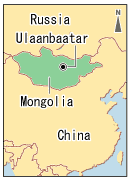(20)Spreading the song of Sadako by Kazumasa Kondo
Sain bainuu?
In Mongolia, this means "hello." What do you imagine when you think of Mongolia? Perhaps a vast, grassy plain, nomads, and the homeland of two champion sumo wrestlers, Asashoryu and Hakuho. Recently, too, its rich natural resources have drawn attention in Japan. In addition, though, Mongolia and Hiroshima share some important ties.
This year is the 35th anniversary of the establishment of diplomatic relations between Japan and Mongolia. As part of "Japan Year in Mongolia," the two governments have organized a number of events to share Japan with the people of Mongolia. One of these events, held on August 6th at a children's art center in Ulan Bator, was an exhibition entitled "The Atomic Bomb and Human Beings."

At the opening ceremony of the exhibition "The Atomic Bomb and Human Beings." Local children eagerly took part, studying the display and praying for peace. (August 5th)
Kazumasa Kondo
Born in Aichi prefecture. After completing graduate school, he worked as a lecturer at Asia University then became an official of the Ministry of Foreign Affairs in 2003. Until September 2007, he worked at the Japanese Embassy in Mongolia.
At the opening ceremony of the exhibition, the director of the art center, Mr. Tserendorj said in some remarks, "The tragedy of the atomic bomb must never be repeated. This exhibition has been organized to pass on the legacy of that day to the next generation." Although the exhibition was held during summer vacation, many young people attended. Traditionally, the people of Mongolia have been keenly aware of issues involving nuclear disarmament.
Another link with Hiroshima is a song about Sadako Sasaki called "The Girl of Hiroshima and her Folded Cranes." A popular Mongolian singer, Oyunna, introduced this song to Japan. Since the song was released in 1979, it has been sung widely in efforts to convey the tragedy of the atomic bombing and promote the importance of peace.
In October 2005, for the 60th anniversary of the bombing, the Japanese Embassy, in cooperation with the children's newspaper "Tsokh," organized an "Atomic Bomb Exhibition" to display materials from Hiroshima's Peace Memorial Museum. The visitors folded paper cranes and about 3000 cranes were sent to the Children's Peace Monument in Peace Memorial Park in Hiroshima.

At the National University of Mongolia, a Hiroshima NGO has designed a "Hiroshima Room." This permanent exhibition conveys information on the bombings of Hiroshima and Nagasaki as well as Japanese culture.
In 1992, Mongolia declared the status of a nuclear-weapon-free state at the United Nations General Assembly and, in 1998, the General Assembly adopted a resolution to support this status. In February 2007, Shinzo Abe, the former Japanese Prime Minister, and Mongolian President Enkhbayar signed the "Ten-Year Action Plan for Japan and Mongolia." In it, Japan pledges to respect Mongolia's non-nuclear status and "cooperate to preserve and strengthen the principles of nuclear non-proliferation and disarmament based on the Nuclear Non-Proliferation Treaty."
The relationship between Japan and Mongolia has grown in every field with the goal of building a "comprehensive partnership." Mongolia is a like-minded supporter of Japan, the only country to suffer nuclear attack, as it strives to realize a world free of these weapons.